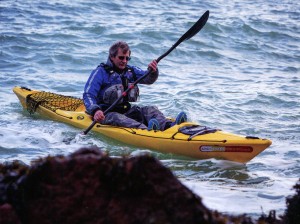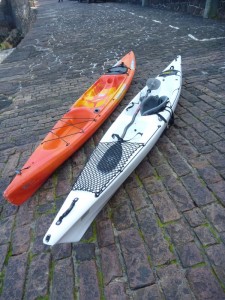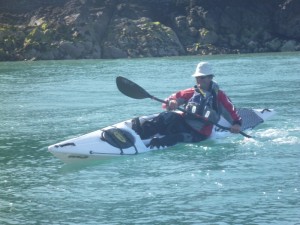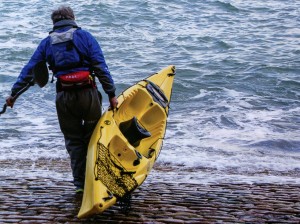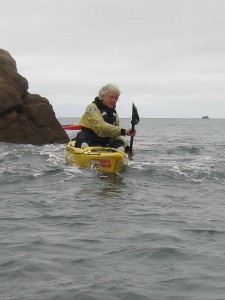DAG Midway Sit-on-Top Kayak Review
If you first see the DAG Midway from a distance, or as an upturned kayak on a dealers rack, it’s likely that you will not realise it is a sit-on-top kayak until you look closely or flip it upright.
This is a kayak that aims to position itself between two different segments of the paddle sport market. Hence the name “Midway”.
Described by DAG Kayaks (now part of RTM) as “fast, elegant and of high performance, the Midway combines the performance of a traditional sea kayak (speed, manoeuvrability, responsiveness) with that of a sit-on-top.” This certainly sets a design challenge and considering the design has been about since around 2010, the surprising thing is how few Midways are about.
It’s worth noting that the Midway has a brother the Tiwok evo, which is a very similar to the Midway but is a sit inside style sea kayak and 5cm narrower. RTM also produce a similar style of kayak, the Disco+ which is a little shorter (428cm) with a max load listing of 120kg. But more about max weights later …
Technical bits
Roto-moulded plastic construction
Length: 440cm
Width: 65cm, 25.6”
Weight: 23kg, 51lbs
Max load: 140kg, 308lbs
Colours: Sunburst and White options.
Front hatch with water tight bulkhead
Grab handles fore and aft and on side
Removable thigh brace
Fishing rod holder.
Background
I’ve owned a Dag Midway for over two years and this is my second Midway. I was lucky to get long term use of an earlier model – which my dealer accepted as a trade in (there’s a clue here). The main difference is the hatch cover has changed. In the past two years I have paddled the Midway in excess of 300 times on both sit-on-top kayak tours and also in more challenging waters.
Why did I buy the Midway
As a professional sea kayak coach running tours and coaching for both sit-on-top and sit inside sea kayakers, I wanted a more responsive sit-on-top kayak.
The mainstay of our fleet is the Ocean Kayak Scupper Pro, a great kayak and one which has stood the test of time both in terms of its design and build. Though I could use a sit inside kayak on our sit-on-top courses and tours, I feel this might distance myself from clients as there are differences between sit-on-top and sit inside kayaks and users. Plus, if I were to use a sit inside kayak hopping onto beaches, working in challenging conditions etc. might be less easy and I might lose empathy with our paddlers. On paper the Midway looked like a good compromise for my needs.
Build
Both models arrived well kitted out. Handles and fittings are in the right places and my current model has drain holes in better positions. The ‘D rings’ for lines and the straps are of good quality with no sign of rust. The rubbing strip at the stern is made from a more solid material than found on the Prowlers.
The seat area is quite wide, which suggests a large paddler will fit. The height of the moulded back tends to encourage you to lean back more than is needed. I solved this by gluing extra paddling made from sleeping mat foam. As a result I now have a customised seat with better connectivity and a warmer and drier bottom!
On my earlier Midway I experimented with seats such as the designs by Feelfree and also the Ocean Kayak Comfort Pro. The latter, though very comfortable and hard wearing, increased the centre of balance by more than 1½ inches making the kayak more tippy. The position of the D rings (attached to the handles) needed changing to reduce the length of strap running from the seat to the D ring mount for both the Ocean Kayak and Feelfree seats. This was easily achieved by moving the D ring on the handle from the forward position to the rear.
A deck-line runs almost the whole length of the kayak which is great for rescues and hauling the kayak out the water.
The rear stern tank well comes with a net to keep items from washing overboard. I found this a bit of a nuisance as it gets tangled with equipment and have removed it.
A bow hatch with an internal bulkhead is fitted which is very water tight. If you end up with water between the bulkhead and stern section a thoughtfully recessed drain plug is added. I rarely need to use this drain plug which reflects the excellent construction.
The drain holes are well thought out but the diameter is small, so an Eckla sit-on-top Kayak trolley might not be a good thing to use in case you damage the seams around the drain holes.
The thigh brace
If you have paddled a surf ski, this will look familiar and enable the paddler to brace themselves in rough water or perform more radical moves. The thigh brace increases your connectivity with the kayak to allow more edging and support strokes in rough water. With a bit of practice rolling is possible but you need to keep your legs pressing inwards against the thigh brace.
Self rescues with the thigh brace installed can be tricky. If you use the over the side method the thigh brace can get in the way as you rotate your bottom into the seat. A lot depends on your agility and build so it is worth practising in advance.
The hull has a notable transition between primary and secondary stability. This tippiness will not come as a surprise if you have paddled various sit in kayaks. If you are used to a more flat bottomed sit-on-top kayak expect a few surprises.
The recessed channels on the hull add strength but the front two drain holes do result in a bit of hull distortion occurring. However, this is not as much as seen in some sit-on-top designs. In hot or cold weather you might also need to loosen the stern drain plug to stop the hull distorting (which also indicates just how airtight the stern section is).
Weight range
140kg is listed as the maximum loading weight and you’d therefore assume this suggests a paddler weighing to 20 stone can paddle this kayak. This is grossly over the top and is based on how much weight can be applied while the kayak remains afloat. A problem is that some brochures and websites have taken the maximum loading rather than the maximum paddlers weight as the benchmark. Search around and you will find that the recommended maximum paddlers weight is a more realistic 90kg (200lbs). However I’d suggest around 80-85kg might be a better guide.
Paddling
As you might by now guess the Midway is a lively craft which, given its hull design and length, make it quite manoeuvrable in a range of conditions. Compared to the Scupper Pro I find the Midway more responsive. However, there does not seem to be much difference in speed between the Scupper Pro and Midway and a few of my instructors feel equally at home paddling the Scupper Pro. Given a choice many would still opt for the Scupper Pro over the Midway.
Connectivity – especially with the thigh brace fitted – makes a big improvement in handling. This lets you paddle in bumpy waters where you can rely on your edging and support skills. Coming from a surf/white water and sea kayaking background means I enjoy experiencing a responsive kayak in moving water. This contrasts with many sit-on-top designs which have little to stop your bottom lifting off the seat when bracing or edging.
Initial stability is a bit sensitive when sitting still but improves once you are moving. Secondary stability is good providing you are used to slightly transferring weight to one side when stationary. The Midway will lean over a lot before you reach the point of no return so sculling and support strokes are worth developing to allow you to get the most from this kayak.
In rough water and tide races – like with many sit-on-top kayak designs – the open seating area fills with water and takes a couple seconds to drain, while you feel as if you are the captain of a submarine. Compared to the Scupper Pro life on the Midway at this point can feel a bit less stable, but if you keep the kayak moving this sensation is overcome. In swell and surf the Midway tracks quite well and once the kayak broaches the thigh brace helps you remain connected with the craft. Having a bit more speed is useful in headwinds.
In beam winds or swell there is a slight tendency for the freeboard to catch more than the Scupper Pro.
If you are coming to the Midway from a background with sit inside sea kayaks and some of the higher performance designs, then the transition will not feel very different. Much will depend on your personal preferences in terms of length and handling requirements. You may also be more critical of the design as a result of the limitations of not having any connection with the deck for your knees/thighs and exposure to the elements.
If you are used to sit-on-top kayaks, be prepared to step up your paddle skills because this is a lively and responsive kayak.
Fishing from the Midway
Though a fishing rod holder is included, this is a design which is going to appeal to the more experienced paddler who fancies doing a spot of fishing rather than the other way around. Reaching behind for gear may feel unstable, even when your legs are dropped over each side of the kayak to give more stability. The minimalist angler will perhaps find this less of an issue. Some report the thigh brace makes it harder to move about and change position, if fishing for any length of time.
Unlike the Midway the Scupper Pro makes angling a little easier and allows more freedom of movement.
Who is likely to buy the Midway?
This is a kayak that is perhaps best suited for a paddler around 85kg or less, who ideally has a good repertoire of paddle skills. The Midway has that little bit of ‘edginess’ which makes it fun to use, if you enjoy getting out for a spot of paddling instead of heading for the gym. A smaller built paddler, who finds it hard to keep up with friends paddling some sit-on-top designs, may also find the speed and liveliness a good option.
The person already paddling a sit inside sea kayak is unlikely to find a reason to use the Midway unless they often find themselves paddling solo and do not have a reliable roll. If they also paddle with friends who use sit-on-top kayaks then the Midway may bridge both types of craft.
Approach the Midway from a sit-on-top kayak background and you need to have, or be willing to spend, time developing a range of paddle skills. This design will give you more confidence compared to using a sit inside sea kayak, though you cannot just jump onto the Midway and paddle away – which may explain why it has not been hugely popular with sit-on-top kayakers in the UK. The reason I ended up getting long term use of my first Midway from our local dealer was because the original buyer though wanting a sporty kayak did not have the range of skills to rally get to grips with it.
The Midway is a kayak you must try before you buy and preferably give it a few tests to see how you get on with it. And: ensure you practice your self rescue techniques due to the thigh brace and wear appropriate paddle gear and carry safety kit, unless you want some big scares.
To put it in a nut shell: The Midway requires a good foundation of paddle skills. Once mastered the Midway will be fun to paddle and gets you whizzing around the coast. Just don’t think of the Midway as being like most sit-on-top kayaks.

